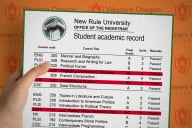You have /5 articles left.
Sign up for a free account or log in.

More universities are seeking dedicated leaders for microcredential programs.
Maxxa_Satori/iStock/Getty Images Plus
Amy Heitzman noticed a new trend when UPCEA, an online and professional education association, put out calls last year to institutions looking to bulk up microcredential programs.
“Five of the 40 [applicants] said, ‘We’re going to hire someone to head this up,’” said Heitzman, UPCEA’s deputy CEO and chief learning officer. “And it was like, ‘Oh?’ But it was not surprising, because it’s essential.”
Microcredentials—also known as digital badges, credentials, certificate, or alternative credentials—grew in popularity during the COVID-19 pandemic. Now they are attracting renewed interest as institutions look to widen their nets for nontraditional students as an enrollment cliff looms.
In addition to backing these programs, some universities are going further by hiring staff solely to oversee microcredential efforts.
“If you’re a mature [microcredential] program, you’re figuring out how to make it only get better,” Heitzman said. “If you’re new to this space, you’re doing this from a holistic place of ‘Maybe we need a keeper to lead this institution in X or Y.’ It’s institutions recognizing, ‘We need to step into this space. We need commitment from the top down.’”
In the last month, the University of Texas Medical Center has joined that club, seeking a director for the Office of Personalized Professional Success. Meanwhile, the University of Nebraska at Lincoln has been looking for a coordinator of microcredentials and badging.
UNL’s search began after a successful 2022 microcredential pilot project at its agriculture school. University officials wanted to expand the program, but it was clear they needed a point person.
“The awarding [of microcredentials] is not the difficult process; it’s building them and how to market them,” said Kevin Shriner, assistant vice chancellor for digital and online learning at UNL. He said the university recognized that running microcredential programs “was a lot of work, and we knew we would need someone to concentrate on the nondegree side and the degree side.”
One of the first people in the nation to take on a microcredential leadership role is Anne Reed, director of the office of microcredentials at the University at Buffalo since 2017. The State University of New York had sought to roll out microcredential programs across the SUNY system, and Reed helped launch that effort at UB in 2018.
The University at Buffalo, which does not exactly fit the image of an institution usually associated with microcredentials, has no large online course program and is, according to Reed, a “place-based institution.”
“We’re still a very research-intensive university, but we want to be known for innovation and have opportunities for all types of learners,” she said. “I think everyone sees the universities are changing, and we need to change, too, otherwise we won’t be able to serve all those who need to be served.”
Reed said that while there was a post-COVID period when microcredentials appeared as a potential “fad,” they have proven to have staying power.
“I think there are folks who are just now realizing, ‘It’s not going away; how do we participate in a way that’s right for our institution?’” she said. “There will always be an interest in alternative credentials; there’s no way around lifelong learning. We have to be continuously learning and getting credentialed.”
The specific nature of a microcredential program and its coordinator is largely dependent on the institution, but there are typically two paths, according to UPCEA’s Heitzman. She said microcredential coordinators can focus on working within the institution, partnering with faculty on potential microcredential ideas, getting approval from the necessary boards and ensuring course quality. Alternatively, there are also leaders who work externally with community members to ensure workforce needs are met.
The latter is crucial for a successful microcredential program, according to Shalin Jyotishi, senior adviser for education, labor and the future of work at New America.
“There’s very little rationale for higher education institutions to offer microcredentials in which an employer isn’t directly involved, period,” he said. “A microcredential signals competency in a specific set of skills. It’s incumbent on institutions to work with employers to ensure microcredential offerings are equipping students with skills employers need.”
He said the time is ripe for four-year institutions to work with community colleges. The latter have historically built strong relationships with community organizations and businesses with a finger on the pulse of workforce needs. The former, on the flip side, can help two-year institutions with the infrastructure needed in online and large-scale programs.
For universities that do not have the resources to dedicate a full-time staff member to a burgeoning microcredential program, Heitzman suggested creating a “coalition of the willing” to coordinate efforts.
“Talk internally about what you can do and what you can do in partnerships,” she said. “Either with other institutions or the low-hanging fruits of the employers of the region.”









